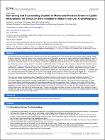| dc.contributor.author | CAFFREY, MARTIN | en |
| dc.date.accessioned | 2014-06-26T13:45:52Z | |
| dc.date.available | 2014-06-26T13:45:52Z | |
| dc.date.issued | 2012 | en |
| dc.date.submitted | 2012 | en |
| dc.identifier.citation | Li, D., Boland, C., Walsh, K., Caffrey, M., Use of a Robot for High-throughput Crystallization of Membrane Proteins in Lipidic Mesophases, Journal of Visualised Experiments, 67, 2012, e4000 | en |
| dc.identifier.other | Y | en |
| dc.identifier.uri | http://hdl.handle.net/2262/69881 | |
| dc.description | PUBLISHED | en |
| dc.description.abstract | An important route to understanding how proteins function at a mechanistic level is to have the structure of the target protein available, ideally at atomic resolution. Presently, there is only one way to capture such information as applied to integral membrane proteins (Figure 1), and the complexes they form, and that method is macromolecular X-ray crystallography (MX). To do MX diffraction quality crystals are needed which, in the case of membrane proteins, do not form readily. A method for crystallizing membrane proteins that involves the use of lipidic mesophases, specifically the cubic and sponge phases1-5, has gained considerable attention of late due to the successes it has had in the G protein-coupled receptor field6-21 (www.mpdb.tcd.ie). However, the method, henceforth referred to as the in meso or lipidic cubic phase method, comes with its own technical challenges. These arise, in part, due to the generally viscous and sticky nature of the lipidic mesophase in which the crystals, which are often micro-crystals, grow. Manipulating crystals becomes difficult as a result and particularly so during harvesting22,23. Problems arise too at the step that precedes harvesting which requires that the glass sandwich plates in which the crystals grow (Figure 2)24,25 are opened to expose the mesophase bolus, and the crystals therein, for harvesting, cryo-cooling and eventual X-ray diffraction data collection.
The cubic and sponge mesophase variants (Figure 3) from which crystals must be harvested have profoundly different rheologies4,26. The cubic phase is viscous and sticky akin to a thick toothpaste. By contrast, the sponge phase is more fluid with a distinct tendency to flow. Accordingly, different approaches for opening crystallization wells containing crystals growing in the cubic and the sponge phase are called for as indeed different methods are required for harvesting crystals from the two mesophase types. Protocols for doing just that have been refined and implemented in the Membrane Structural and Functional Biology (MS&FB) Group, and are described in detail in this JoVE article (Figure 4). Examples are given of situations where crystals are successfully harvested and cryo-cooled. We also provide examples of cases where problems arise that lead to the irretrievable loss of crystals and describe how these problems can be avoided. In this article the Viewer is provided with step-by-step instructions for opening glass sandwich crystallization wells, for harvesting and for cryo-cooling crystals of membrane proteins growing in cubic and in sponge phases. | en |
| dc.format.extent | e4000 | en |
| dc.language.iso | en | en |
| dc.relation.ispartofseries | Journal of Visualised Experiments | en |
| dc.relation.ispartofseries | 67 | en |
| dc.rights | Y | en |
| dc.subject | Materials Science | en |
| dc.subject | Issue 67 | en |
| dc.subject | crystallization | en |
| dc.subject | glass sandwich plates | en |
| dc.subject | GPCR, | en |
| dc.subject | harvesting | en |
| dc.subject | in meso | en |
| dc.subject | LCP | en |
| dc.subject | lipidic mesophases | en |
| dc.subject | membrane protein | en |
| dc.subject | macromolecular X-ray crystallography | en |
| dc.title | Use of a Robot for High-throughput Crystallization of Membrane Proteins in Lipidic Mesophases | en |
| dc.type | Journal Article | en |
| dc.type.supercollection | scholarly_publications | en |
| dc.type.supercollection | refereed_publications | en |
| dc.identifier.peoplefinderurl | http://people.tcd.ie/mcaffre | en |
| dc.identifier.rssinternalid | 87242 | en |
| dc.identifier.doi | http://dx.doi.org/10.3791/4000 | en |
| dc.rights.ecaccessrights | openAccess | |




